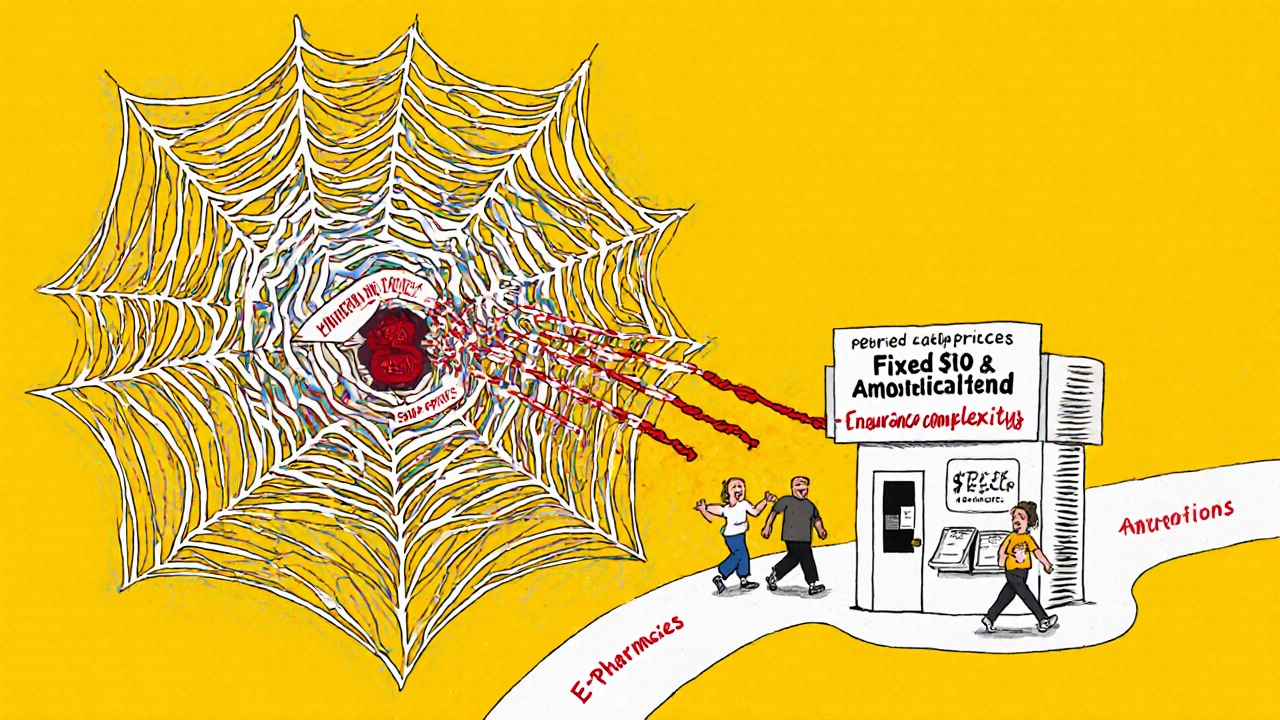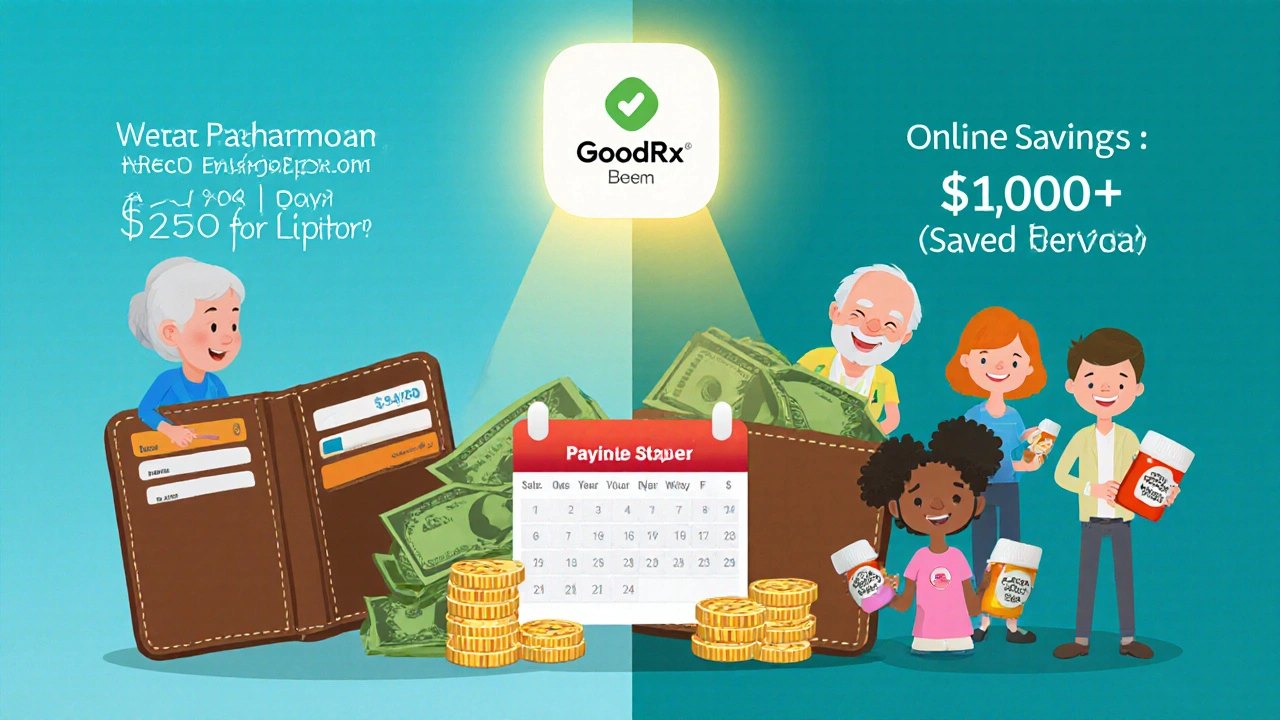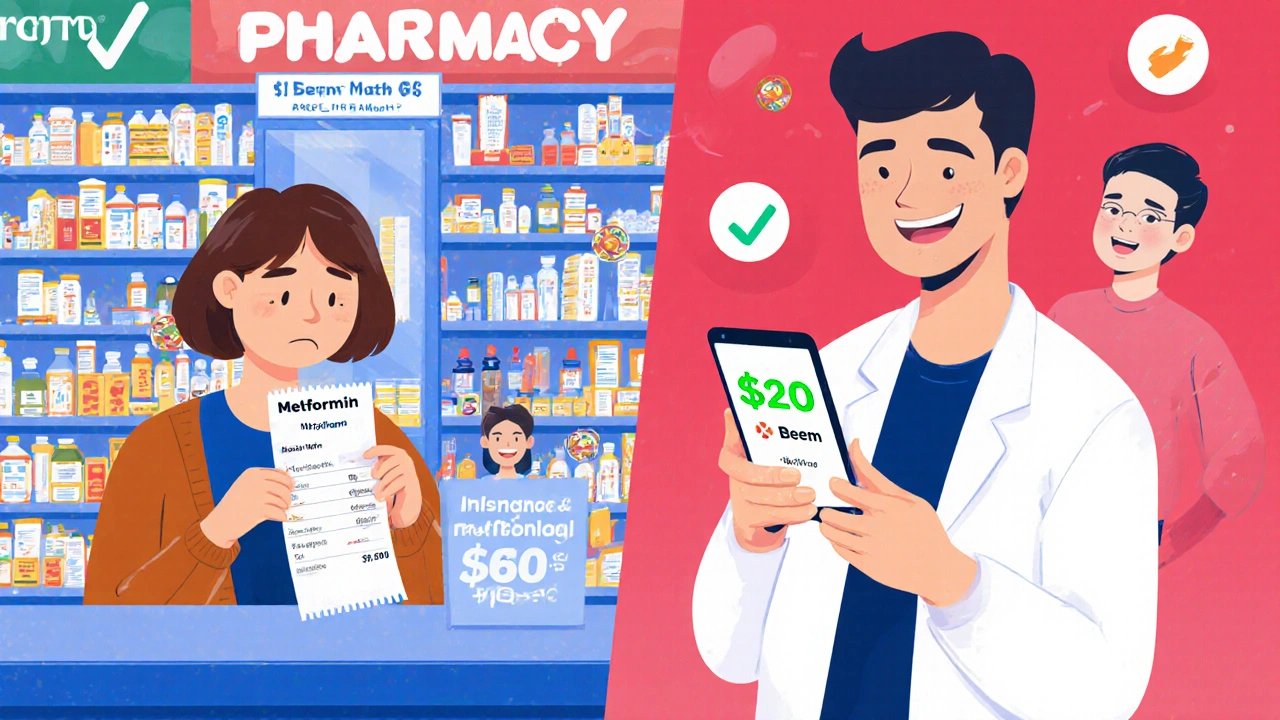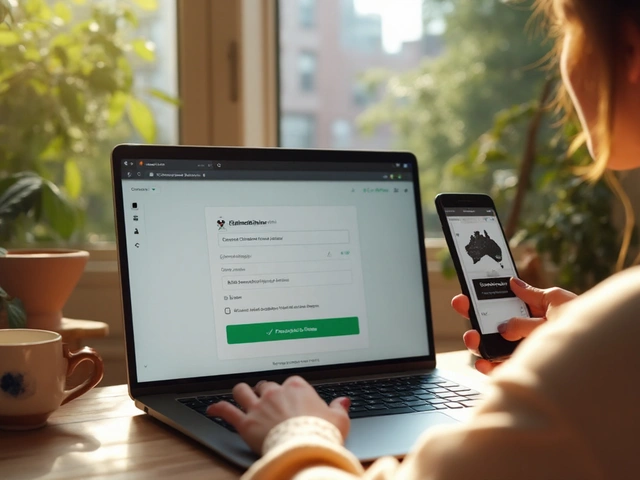Buying generic prescription drugs online can save you hundreds of dollars a year - if you know where to look. Many people still walk into their local pharmacy and pay whatever the cash price is, not realizing that the same medication might cost less than a third of that on a simple app or website. The truth? The price of your generic pills isn’t set by law. It’s set by who you buy from.
Why Your Pharmacy Bill Feels Random
If you’ve ever bought Lipitor, Metformin, or Amoxicillin at a retail pharmacy like CVS or Walgreens, you’ve probably been shocked by the price. One month it’s $60. The next, it’s $75. No explanation. No warning. That’s because retail pharmacies don’t have fixed prices. They use a formula most people don’t understand: Average Wholesale Price (AWP) plus a markup and a dispensing fee. For example, a pharmacy might charge you AWP + 20% + $5. That sounds technical, but here’s what it means: the same pill can cost $250 at one store and $50 at another - because each pharmacy negotiates a different price with their distributor. This system was designed for insurance billing, not cash customers. And if you’re uninsured or underinsured, you’re stuck paying the full, inflated cash price. No discounts. No transparency. Just whatever the counter says.How E-Pharmacies Cut the Middleman
Online platforms like Beem, GoodRx, and SingleCare don’t sell medicine themselves. They’re price matchmakers. They go directly to pharmacies - big chains and small independents - and negotiate fixed, discounted rates for common generic drugs. No AWP. No hidden markups. Just a clear, upfront price you can see before you even leave your house. Take Metformin 500mg (30 tablets). At a retail pharmacy, it’s often $60. On Beem? $20. Amoxicillin? $30 at CVS. $10 online. Lipitor? $250 in-store. $50 through an e-pharmacy. These aren’t outliers. They’re the norm. The key difference? E-pharmacies skip the Pharmacy Benefit Managers (PBMs) - the middlemen who negotiate deals between drug manufacturers, insurers, and pharmacies. PBMs create complexity. Online platforms cut it out. They go straight to the source. That’s why their prices are so low.Real Savings, Real Numbers
A 2023 analysis by Trybeem looked at 15 of the most common generic prescriptions. Here’s what they found:- Metformin (500mg, 30 tablets): $60 retail vs $20 online
- Amoxicillin (500mg, 30 capsules): $30 retail vs $10 online
- Lipitor (Atorvastatin 20mg, 30 tablets): $250 retail vs $50 online
- Levothyroxine (50mcg, 30 tablets): $45 retail vs $12 online
- Simvastatin (20mg, 30 tablets): $55 retail vs $15 online
But What About Insurance?
You might be thinking: “But I have insurance. Why should I care?” Here’s the catch: your insurance copay isn’t always cheaper. Sometimes, the cash price through an e-pharmacy is lower than your insurance copay. Especially for generics. A 2023 Ohio State University study found that for 76% of medications, the out-of-pocket cost difference between insured retail and direct online pricing was less than $200 per year - and for many, it was zero. In some cases, like specialty drugs for conditions like multiple sclerosis, insurance might still win. But for routine meds? Online often beats insurance. And here’s the kicker: you don’t need insurance to use these platforms. You just need a prescription. That’s huge for people without coverage, or those on high-deductible plans who haven’t met their deductible yet.
Where E-Pharmacies Fall Short
It’s not all perfect. These platforms are best for common, stable, generic medications - the kind you take every day. They’re not great for specialty drugs. Glatiramer acetate, fingolimod, cyclosporine - these are expensive no matter where you buy them. Even online, they’re still hundreds or thousands of dollars a month. But here’s the thing: even those prices are often lower than retail. Another limitation? Immediate access. If you need your meds today, walking into a pharmacy is faster than waiting for shipping. That’s why retail still wins for urgent needs, new prescriptions, or if you need to talk to a pharmacist on the spot. Also, not every pharmacy in your area participates. You’ll see a list of nearby locations that accept the discount. Sometimes, it’s just one or two. But that’s still better than paying full price at the closest one.Convenience Isn’t Just About Speed
Online platforms don’t just save money - they make managing meds easier. Most have apps that send refill reminders. You can track your spending. You can compare prices across multiple pharmacies in your ZIP code. You don’t have to drive, wait in line, or interrupt your day. For older adults, people with mobility issues, or those with busy schedules, that’s not a luxury. It’s essential. And the trend is clear. J.D. Power’s 2025 U.S. Pharmacy Study found that satisfaction with mail-order and online pharmacies is rising steadily. More people are using them. More people are happy with them.The Bigger Picture: Why This Matters
The U.S. spends more on prescription drugs than any other country. A 2024 Congressional Budget Office report showed that brand-name drug prices have grown 4% a year above inflation. Generics are better, but even they’ve crept up. Meanwhile, the retail pharmacy market is dominated by just a few big chains. Independent pharmacies are closing. PBMs control the system. Patients are left paying the price. E-pharmacies are disrupting that. They’re forcing transparency. They’re giving people power. And they’re proving that lower prices are possible - without sacrificing quality or safety. The global mail-order pharmacy market is projected to hit $249 billion by 2029. That’s not a fad. That’s a shift. And it’s happening because people are tired of overpaying.
What You Should Do Right Now
Here’s how to start saving today:- Find your prescription. Write down the name, strength, and quantity (e.g., Metformin 500mg, 30 tablets).
- Go to Beem, GoodRx, or SingleCare on your phone.
- Enter your drug info. The app will show you prices at nearby pharmacies.
- Choose the lowest price. You’ll get a coupon or code.
- Take it to the pharmacy. Show the pharmacist the code. Pay. Done.
FAQ
Are online pharmacy prices safe and legal?
Yes. Platforms like GoodRx, Beem, and SingleCare don’t sell drugs. They connect you to licensed U.S. pharmacies that already stock the medication. You still get your prescription filled by a real pharmacist. The discount is just negotiated upfront. These are not foreign or unregulated sites. They’re partnerships with local pharmacies that accept cash discounts.
Can I use these discounts with my insurance?
You can’t combine them. But you can choose which one is cheaper. Sometimes the cash price through GoodRx is lower than your insurance copay. Always check both before paying. The app will show you your insurance price too, so you can compare side by side.
Do I need a prescription to use these services?
Yes. You still need a valid prescription from your doctor. These platforms don’t replace your doctor or pharmacy - they just help you pay less. You can usually send your prescription electronically to the pharmacy through the app.
Why is the same drug cheaper online than at my local pharmacy?
Because retail pharmacies use a pricing formula (AWP + markup) designed for insurance billing. Online platforms negotiate fixed, discounted cash prices directly with pharmacies. They cut out middlemen like PBMs and pass the savings to you. Your local pharmacy might still charge you more because they haven’t agreed to the same discount deal.
Are there any hidden fees with e-pharmacies?
No. The price you see is the price you pay. Some platforms offer free shipping, others charge a small fee for delivery. But there are no subscription fees, no membership costs, and no surprise charges at checkout. You pay the displayed price at the pharmacy counter.
What if my pharmacy doesn’t accept the coupon?
That’s rare, but it can happen. First, make sure you’re showing the correct barcode or code. If it’s still rejected, call the pharmacy’s customer service line - they often have a way to manually process it. If not, try another pharmacy on the app’s list. There are usually multiple options nearby.
Can I use these for my pet’s medications?
Sometimes. Some human medications are used for pets, like antibiotics or thyroid pills. But you need a vet prescription, and not all pharmacies will fill them. Check with the pharmacy first. Some online services, like Chewy, specialize in pet meds and offer their own discounts.





November 20, 2025 AT 08:18 AM
just used goodrx for my metformin turned out to be 18 bucks at the corner walgreens wow
November 21, 2025 AT 13:30 PM
this is such a critical breakdown of the PBM mess. the AWP system is a scam designed to obfuscate pricing so pharmacies can jack up cash prices without accountability. i work in med admin and see the spreadsheets daily-retail pharmacies are forced to inflate because PBMs take 15-20% off the top before they even get to the shelf. e-pharmacies bypass all that. it’s not magic, it’s just direct contracting. also, side note: most pharmacists *want* you to use these apps. they hate seeing patients skip meds because they can’t afford the sticker price.
November 22, 2025 AT 02:51 AM
lol so now we’re trusting apps run by shady investors who secretly own pharmacy chains? next you’ll tell me the FDA isn’t in on it. these platforms? they’re just front companies for the same PBMs that’ve been ripping us off for decades. you think they’re giving you savings? nah-they’re just shifting the markup from insurance billing to cash. watch-next year, the ‘discounted’ price goes up 40% and your ‘insurance’ copay drops to match. it’s all a game. the real solution? single-payer. not some app with a discount code.
November 23, 2025 AT 03:18 AM
okay but... why is this even a thing? like... why do we have to be hackers just to afford medicine? it’s 2025. we have drones and AI and yet a diabetic has to play price-war bingo just to not die? i’m not impressed. this is a band-aid on a hemorrhage. also-did you know the person who wrote this probably has a 401k and a private plane? just saying.
November 23, 2025 AT 19:35 PM
OMG I JUST DID THIS!! 😭😭😭 I’ve been paying $58 for my levothyroxine for 3 years. Used Beem today. $11. AT MY LOCAL CVS. I cried in the parking lot. My pharmacist gave me a hug. I told her I was gonna tell everyone. This isn’t just money. It’s peace of mind. 🤍 You guys need to try this. I’m not even joking. My anxiety dropped 80% because I stopped worrying about the next refill. PLEASE. DO THIS. FOR YOURSELF.
November 25, 2025 AT 15:37 PM
bro this is the real deal. i’m from delhi and we’ve been doing this for years with local pharmacies offering cash discounts-no middlemen, no insurance nonsense. america’s system is wild. but you’re right-e-pharmacies are like the indian kirana store model: direct, transparent, community-based. the only thing missing? more rural pharmacies joining in. i’ve seen folks in rural texas still paying $80 for insulin because they don’t have cell service or trust apps. we need outreach-not just tech. maybe partner with churches, libraries, community centers. this could save lives. seriously.
November 26, 2025 AT 20:10 PM
you’re ignoring the real issue: these apps are a distraction. they don’t fix the system. they just let you feel better while the system keeps crushing people. also, you’re assuming everyone has a smartphone. what about the elderly? the homeless? the disabled? this isn’t empowerment-it’s elitist tech-washing. and don’t even get me started on the data harvesting. you think your drug history isn’t being sold? think again.
November 27, 2025 AT 06:55 AM
i just want to say thank you to everyone who shared this. my mom is on 5 meds and has Medicare Advantage. she thought she was getting the best deal until she tried GoodRx. She’s saving $400/month now. I cried too. But I also called her pharmacy and asked them to start accepting these discounts. They said they would. Small steps. We’re not powerless. If you’re reading this and you’re scared to try it-just do it. One prescription. One app. One less worry. You deserve this.
November 28, 2025 AT 13:25 PM
eh i tried goodrx once and the coupon got rejected. turned out the pharmacy was just being a jerk. now i just buy my meds in mexico. cheaper, faster, and no app needed. also, i think the whole thing is a government plot to get us addicted to phones
November 28, 2025 AT 16:03 PM
as a black woman from the south, i gotta say-this is the kind of info that gets buried. my grandma died because she skipped her pills to pay rent. i wish someone had told us about this back then. now i teach my cousins how to use these apps. it’s not just about money-it’s about dignity. and if you’re still skeptical? try it. for one pill. you’ll be shocked. i promise.
November 29, 2025 AT 03:12 AM
how dare you suggest that people should just use an app? this is capitalism at its most grotesque. you’re normalizing the idea that people should be hustling just to survive. why aren’t we out in the streets demanding universal drug pricing? instead, we’re being told to download a coupon app like it’s a lifestyle upgrade? this isn’t empowerment. it’s gaslighting dressed up as helpful advice. 🙄